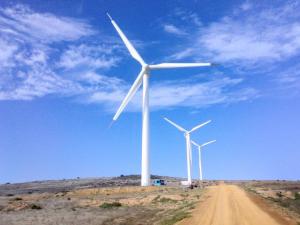The South African government is marshalling a slow move to broadening the country’s energy resources.
South Africa’s grid is coal-dependent, with about 90% of the country’s energy coming from coal.
State-owned power utility Eskom is building two new coal-fired power stations, although the technology used will mean reduced emissions of greenhouse gases, related to climate change.
South Africa’s energy grid has received one of its first injections of wind energy since Umoya Energy’s 37-turbine Hopefield wind farm was certified fully operational 10 days ago, Cape Town-based Umoya said on Monday.
The Hopefield wind farm will generate enough electricity to power about 70,000 low-income or 29,000 medium-income homes, it said.
The government, in its newly released Integrated Resource Plan (IRP) for Electricity 2010-2030, plans for a reduced demand for wind energy, from 9,200MW to 4,360MW, just as it cuts projected national capacity requirements to 2030 by 6,600MW. It also moots a delay on a decision on a new nuclear building programme.
Comment on the plan closed last week, and it may be adapted in line with comments received.
Umoya Energy claimed the wind farm was the first in South Africa to achieve its commercial operation date, but South African Wind Energy Association CEO Johan van den Berg could not confirm this. He said it was certainly one of the first.
“I know the majority of the first phase (of wind farms) are very close to commissioning. The first round was about 650MW spread over seven to eight projects,” he said.
Umoya Energy was awarded a power purchase agreement in the first round of the Department of Energy’s renewable energy independent power producer programme, now in its third round of deal-making. It reached commercial operation on February 1.
Close behind was the Metrowind Van Stadens (MWVS) wind farm, which reached its commercial operation date on February 2, Metrowind said in a statement.
The 27MW wind farm had been supplying electrical power to the regional grid since late November 2013 and would sell renewable energy to state power utility Eskom for the next 20 years, in accordance with the terms of a power purchase agreement concluded in November 2012.
The R55m MWVS wind farm is 100% South African-owned, 35% black-owned, and a portion of the project is owned by the Metrowind Community Trust, established by the project developers as a vehicle to deliver their corporate social investment programme.
In addition to the dividends payable to the community trust, 2.1% of the facilities annual revenue to be channeled into socioeconomic development and enterprise development within the community.
Construction on the wind farm, 5km from Hopefield on South Africa’s west coast, began and the project was finished in time and within budget, Umoya Energy said.
Wind has proven to be the cheapest form of new electricity generation in South Africa, averaging R0.74/kWh in the independent power producer programme’s third bid “window”. The first projects have been concluded on time, within budget, which cannot be said for the much larger and more complex projects aimed at delivering power from traditional coal.
Mr van den Berg said there was a large incentive to keep to budget and time constraints because wind-farm operators could not change the sale price negotiated, so they could not pass any budget extensions to consumers or price in lost time.
The roughly R1.45bn Umoya project was financed by Rand Merchant Bank, with equity provided by the Africa Infrastructure Investment Fund, the Kagiso Infrastructure Empowerment Fund and Old Mutual’s Infrastructural, Developmental and Environmental Assets Managed Fund.

